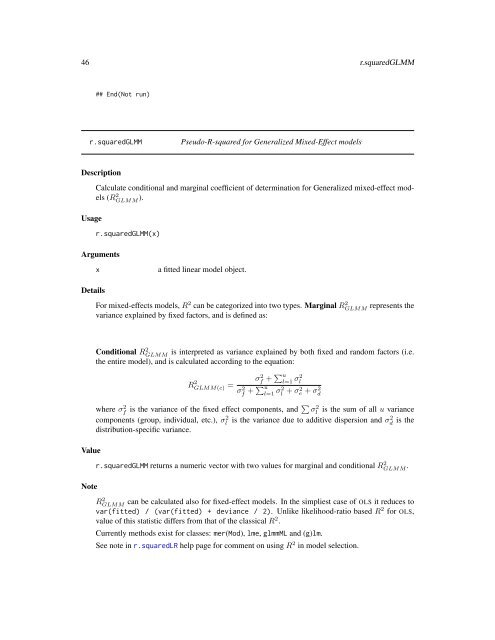Package ‘MuMIn’
Package 'MuMIn'
Package 'MuMIn'
You also want an ePaper? Increase the reach of your titles
YUMPU automatically turns print PDFs into web optimized ePapers that Google loves.
46 r.squaredGLMM<br />
## End(Not run)<br />
r.squaredGLMM<br />
Pseudo-R-squared for Generalized Mixed-Effect models<br />
Description<br />
Usage<br />
Calculate conditional and marginal coefficient of determination for Generalized mixed-effect models<br />
(R 2 GLMM ).<br />
r.squaredGLMM(x)<br />
Arguments<br />
x<br />
a fitted linear model object.<br />
Details<br />
For mixed-effects models, R 2 can be categorized into two types. Marginal RGLMM 2 represents the<br />
variance explained by fixed factors, and is defined as:<br />
Value<br />
Note<br />
Conditional RGLMM 2 is interpreted as variance explained by both fixed and random factors (i.e.<br />
the entire model), and is calculated according to the equation:<br />
R 2 GLMM(c) =<br />
σ 2 f + ∑ u<br />
l=1 σ2 l<br />
σ 2 f + ∑ u<br />
l=1 σ2 l + σ2 e + σ 2 d<br />
where σf 2 is the variance of the fixed effect components, and ∑ σl<br />
2 is the sum of all u variance<br />
components (group, individual, etc.), σl<br />
2 is the variance due to additive dispersion and σd 2 is the<br />
distribution-specific variance.<br />
r.squaredGLMM returns a numeric vector with two values for marginal and conditional R 2 GLMM .<br />
RGLMM 2 can be calculated also for fixed-effect models. In the simpliest case of OLS it reduces to<br />
var(fitted) / (var(fitted) + deviance / 2). Unlike likelihood-ratio based R 2 for OLS,<br />
value of this statistic differs from that of the classical R 2 .<br />
Currently methods exist for classes: mer(Mod), lme, glmmML and (g)lm.<br />
See note in r.squaredLR help page for comment on using R 2 in model selection.


